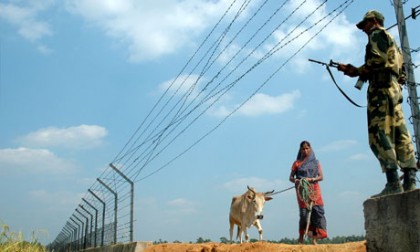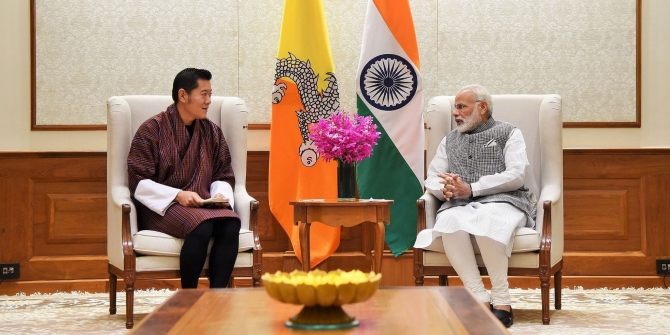LSE’s Romola Sanyal introduces a special issue of Political Geography, “Geographies at the Margins: Borders in South Asia”, and argues that borders and margins are central to understanding South Asia’s history and present.
This special issue began as an attempt to explore the different meanings and forms borders take in South Asia and to study the histories and geographies of borders through an analytical lens that was at once relational and comparative. The region is appropriate for this study not only because of the myriad borders that exist here, but also because much of South Asia’s history, whether in the colonial or postcolonial moment, can be described through the lens of boundary making and border making.
What is more, boundaries in contemporary South Asia tend to bleed into and transpose themselves onto one another. It is a place where international borders are transcribed onto urban regions as communitarian divisions are played out at state frontiers. Border security forces patrol the boundaries of national parks while NGOs regulate the movement of bodies across international boundaries. National histories are re-appropriated by subaltern histories as national identities are increasingly codified from beyond the narrow geographical boundaries of South Asia. Borders and margins in South Asia are therefore central to understanding its history and present.
Our contributors looked at a number of issues to explore the various meanings of marginality in border-zones. Through empirically rich analysis of border spaces, our contributors aimed to draw attention to processes at work within border spaces, and theoretically located these processes within broader networks of marginalisation, dislocation, subaltern theorisation, and contested history.
Our special issue makes two arguments. First, we try to develop an understanding of the region through a focus on its borders and margins. Second, we argue that the link between literature on borders and margins in political and urban geography and beyond is in need of more explicit conceptual linking. While engaging with specific border histories we aimed to draw these out to build theories that trace their troubling linkages to broader issues of nation and state.
The special issue comprises a collection of five papers by Dr Jason Cons (Bucknell University), Dr Sara Schneiderman (Yale University), Dr Townsend Middleton (Duke University), Dr Sara Smith (University of North Carolina, Chapel Hill), and Dr Christina Harris (University of Amsterdam), plus an introduction by Dr Cons and myself that lays out the theoretical arguments for the special issue. The papers analyse issues of citizenship, trade, border crossings, securitisation, and changing ethnic relationships along the borders between India, Bangladesh, Tibet, Ladakh, and Nepal.
Cons takes up the theme of risk in his study of enclaves along the India-Bangladesh border. Drawing theoretically from work on urban slums, he argues for a perspective that is attentive both to the claims residents of Dahagram make about membership in the Bangladeshi state and the counter-histories that such claims occlude. By analysing claims of residents in Dahagram that follow broader patterns and claims of inclusion by those who fall outside of normatively defined notions of national belonging and another set of voices that articulate different sensibilities towards land, marginality, and membership, he demonstrates the ways that the internal politics of this border community articulate with the broader politics of the border itself as well as ethno-nationalist understandings of citizenship in Bangladesh.
Schneiderman studies the Himalayan border zone between Nepal and China and the free transit of residents within 30 kilometres of the Nepal-China border. Here, the border produces subjects that are able to co-opt their political and spatial marginality and use the exceptionality of this marginal space to their advantage. Her work provides a unique insight into how states create alternative forms of citizenship—in this case, border citizenship that runs contrary to better known processes of state formation and citizenship in South Asia and the world. She suggests states are compelled to do so in response to practices from below that complicate the process of managing borders and the movements of people across them.
Middleton looks at how the border in the marginalised region of Darjeeling, India, has served as an important tool for producing political marginality by shaping identities and identity politics. Here, Gorkhas continuously struggle to create an identity and seek recognition by the Indian government, but that is transformed, constrained, or stymied by particular paradigms of recognition in India.
Smith explores the political transformations of Ladakh, a remote and contested region bordering Pakistan and Tibet. Here, Buddhists and Muslims have lived together and intermixed historically, but now the presence of the border dominates the relationships between people, creating tensions between the Buddhist majority and Muslim minority in Leh, the region’s capital. As fears about demographic changes increase, Smith’s work shows how tensions play out against a backdrop of the physical restructuring of buildings and the interpretation of public space along more globalised understandings of Buddhism and Islam. Her work shows the development of ‘a border sensibility’ and raises questions of how borders can produce new and insidious forms of marginality.
Finally, Hariss shows how new political economic developments within the marginal space of the Himalayan region have caused a veritable reshuffling of marginalisations, in which some old spaces of trade are peripheralised while new ones are simultaneously opened up and certain trade practices, while concealed, continue to operate. Through this work she problematises the idea of marginality and argues that it is constantly in flux and contingent on broader changes to economy, connectivity, and power. Hence, these supposedly peripheral areas need to be thought of as being intimately connected to the global economy rather than being isolated.
Dr Romola Sanyal is a Lecturer in Urban Geography at LSE’s Department of Geography and Environment.







2 Comments